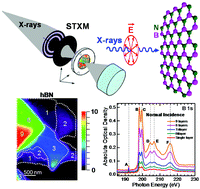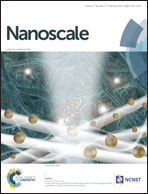Layer speciation and electronic structure investigation of freestanding hexagonal boron nitride nanosheets†
Abstract
Chemical imaging, thickness mapping, layer speciation and polarization dependence have been performed on single and multilayered (up to three layers and trilayered nanosheets overlapping to form 6 and 9 layers) hexagonal boron nitride (hBN) nanosheets by scanning transmission X-ray microscopy. Spatially-resolved XANES directly from freestanding regions of different layers has been extracted and compared with sample normal and 30° tilted configurations. Notably a double feature σ* excitonic state and a stable high energy σ* state were observed at the boron site in addition to the intense π* excitonic state. The boron projected σ* DOS, especially the first σ* exciton, is sensitive to surface modification, particularly in the single layered hBN nanosheet which shows more significant detectable contaminants and defects such as tri-coordinated boron/nitrogen oxide. The nitrogen site has shown very weak or no excitonic character. The distinct excitonic effect on boron and nitrogen was interpreted to the partly ionic state of hBN. Bulk XANES of hBN nanosheets was also measured to confirm the spectro-microscopic STXM result. Finally, the unoccupied electronic structures of hBN and graphene were compared.


 Please wait while we load your content...
Please wait while we load your content...